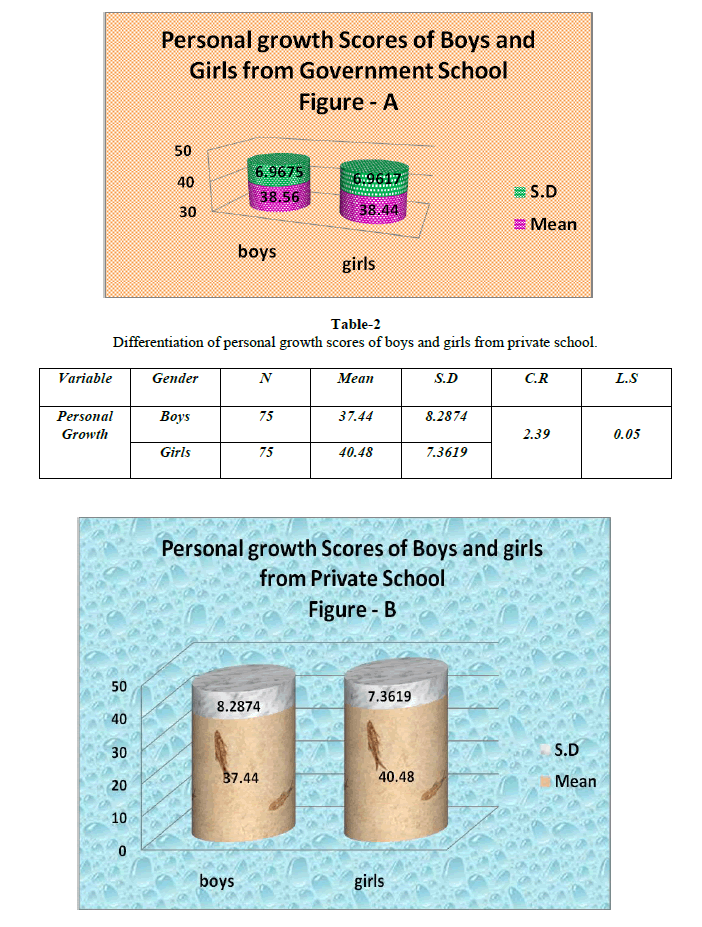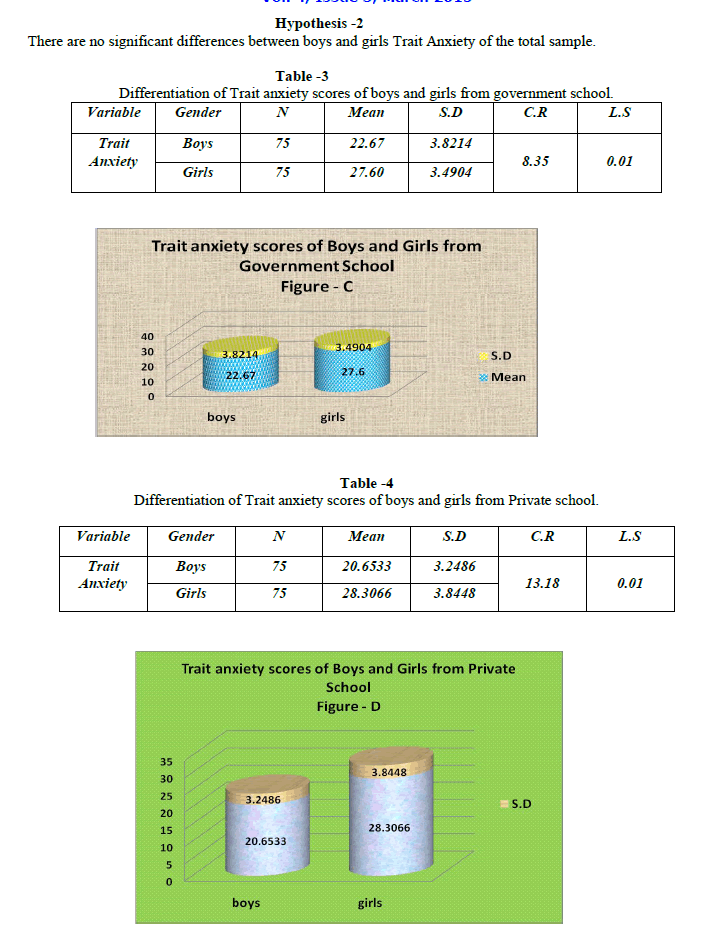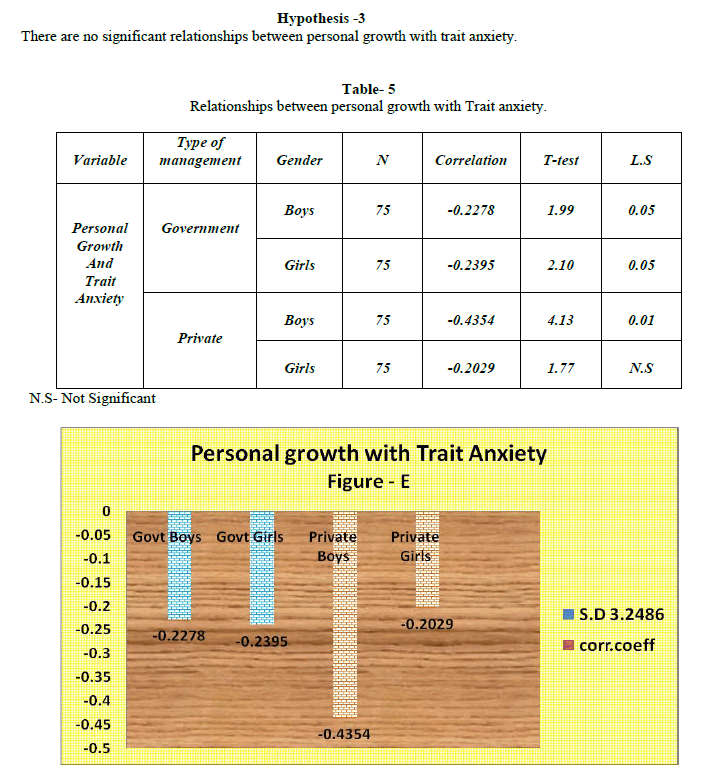ISSN ONLINE(2319-8753)PRINT(2347-6710)
ISSN ONLINE(2319-8753)PRINT(2347-6710)
S.velmurugan 1, K.Saraladevi 2
|
| Related article at Pubmed, Scholar Google |
Visit for more related articles at International Journal of Innovative Research in Science, Engineering and Technology
The study aims to determine Personal Growth and Trait Anxiety among Higher Secondary Students were chosen for the study. A random sampling technique was adapted for the selection of sample the schools selected for this study is divided into different status namely government and private schools. Then random convenient sampling technique was adopted to select the sample 300 students were taken for the study 150 students were drawn from government schools ,150 students were taken from private schools. The students studying in XI standard were chosen as the sample. Personal data sheet developed by the investigator. Personal Growth Initiative Scale by Christine Robitschek (2011), Trait anxiety by Charles D. Speilberger, (1983). Were used to collect data. Results were statistically analyzed through Descriptive Analysis, Differential Analysis, Relational Analysis, and Chi-square Analysis in this study for the personal growth and trait anxiety. Personal growth and Trait Anxiety are negatively correlated to each other and gender as an impact on Personal Growth and Trait Anxiety among Higher Secondary Students.
Keywords |
| personal growth and trait anxiety. |
INTRODUCTION |
| Personal growth is the ability to take an honest and accurate inventory of personal strengths and weaknesses in attitudes, behaviour patterns or habits, choices and action results. Furthermore, personal vices and virtues, lessons learned, intellectual capacity, emotional stability and appropriateness also are included in self-awareness. Such selfexaminations were considered necessary by the Greek philosopher, Socrates for living the Good Life or selfimprovement refers to self-guided improvement economically, intellectually or emotionally most frequently with a substantial psychological or spiritual basis. The basis for self-help is often self-reliance, publicly available information or support groups where people with similar problems join together. From early on exemplars in self-driven legal practice and home-spun advice, the connotations of the phrase have spread and often apply particularly to education, business, psychological or psychotherapeutic nostrums, purveyed through the popular genre of self-help books and through self-help personal-development movements. Any health condition can find a self-help method or group such as parents of the mentally ill. But there are limits and these methods do not work for everyone. Different students have different personalities. Each personality type has students a different idea of what it means to be successful. Selfknowledge is one common goal that will help everyone to achieve personal success. So many students are hung up on somebody else's idea of what it means to be successful, and they are unaware of what is truly important to them. This is completely normal. The students all have important role-models and influencers in our lives that may have basic values that are quite different from our own. If this is the case, it's important to recognize that the discrepancy between what students have been taught is truly important and what students personally believe to be truly important is due to a difference in perspective. If students spend our time and effort trying to meet somebody else's idea of success, and ignore or belittle any conflicting messages from our own psyche, then students will find ourselves exhausted and unhappy. Realizing what is truly important to us is a major step towards achieving personal success. |
PERSONAL GROWTH AT EACH LEVEL |
| 1. Social Accomplishment 2. Psychological Growth 3. Spiritual Progress 4. Transformation Some of these dimensions naturally increase during our lifetimes as a result of life experience and conscious effort. Some of them lend themselves to change by a serious psychological effort. Some can be altered only by spiritual experience. Therefore, those interested in personal growth need first of all to be clear about the differences between these four aspects of personality and the methods appropriate for personal growth at each of these levels. An effective approach to understanding human personality requires a clear distinction between those dimensions that lend themselves to alteration by mental or physical effort, deeper elements that can be changed only by a deeper psychological effort or by the influence of higher (spiritual) consciousness, and those that are virtually fixed for the span of life and can only be altered by yogic transformation. |
TRAIT ANXIETY |
| Anxiety is an unpleasant state of inner turmoil, often accompanied by nervous behaviour, such as pacing back and forth, somatic complaints and rumination. It is the subjectively unpleasant feelings of dread over something unlikely to happen, such as the feeling of imminent death. Anxiety is not the same as fear, which is felt about something realistically intimidating or dangerous and is an appropriate response to a perceived threat; anxiety is a feeling of fear, worry, and uneasiness, usually generalized and unfocused as an overreaction to a situation that is only subjectively seen as menacing. It is often accompanied by restlessness, fatigue, problems in concentration, and muscular tension. Anxiety is not considered to be a normal reaction to a perceived stressor although many feel it occasionally. Anxiety immediate emotional state that is characterized by apprehension, fear, tension, and an increase in physiological arousal. A temporary emotional condition characterized by apprehension, tension, and fear about a particular situation or activity. State anxiety is usually accompanied by physiological arousal and observable behavioural indicators, such as nervous fidgeting, licking the lips, and rubbing the palms of the hands on a shirt or trousers. Anxiety is defined as a psychological and physiological condition that includes various components (behavioural, cognitive, emotional and genetic/somatic), which merge and result in feelings such as nervousness, panic and discomfort. Anxiety can also be categorized as being "state" or "trait," depending on its duration. Trait anxiety-It is defined as the tendency to experience anxiety. Trait anxiety is considered to be a characteristic of personality that endures over time and is manifest across a variety of situation. Anxiety can be either a short term 'state' or a long term "trait." Trait anxiety reflects a stable tendency to respond with state anxiety in the anticipation of threatening situations. It is closely related to the personality trait of neuroticism. Such anxiety may be conscious or unconscious. Trait anxiety refers to a general level of stress that is characteristic of an individual, that is, a trait related to personality. Trait anxiety varies according to how individuals have conditioned themselves to respond to and manage the stress. What may cause anxiety and stress in one person may not generate any emotion in another. People with high levels of trait anxiety are often quite easily stressed and anxious. |
INTER RELATIONSHIP AMONG TRAIT AND PERSONAL GROWTH |
| At a time of increased need for efficient mental health services for college students, empirical studies informing these services are vital. Therefore, the purpose of this study was to investigate the interrelationships between personal growth and trait anxiety. Studies with attachment theory propose that how individuals experience Close relationships has relevance to other areas of their functioning. Finding empirical Evidence linking attachment to measures of wellbeing and psychopathology will help to attain further clarity in interrelationships between major areas of human functioning. Such clarity will, in turn, strengthen efficacy of therapeutic interventions with students. Personal meaning was elected as the measure of wellbeing, whereas Depressiveness and trait-anxiety were indicators of vulnerability to psychopathology. In this study,. It was viewed as individualsâÃâ¬ÃŸ tendencies and preferences with respect to anxiety and avoidance in close-romantic relationships. Personal meaning was conceptualized as the degree to which one perceives his or her life as purposeful and fulfilling. Depressiveness consisted of factors of self-criticism and dependency. Self criticism refers to tendencies of perfectionism, whereas dependency has to do with excessive need and concerns about approval and availability of others for oneâÃâ¬ÃŸs sense of identity and wellbeing. Trait-anxiety was viewed as oneâÃâ¬ÃŸs vulnerability to conceive a variety of life situations as threatening and to react to such situations with elevated degrees of fear, tension and anxiety. |
II. SAMPLE |
| A convenient random sampling technique was adapted for the selection of sample the schools selected for this study and divided into two categories namely government and private schools. Then random convenient sampling technique was adopted to select the sample. 300 students were taken for the study. 150 students were drawn from government schools, 150 students were taken from private schools. The students studying in XI standard were chosen as the sample. |
STATEMENT OF THE PROBLEM |
| Personal Growth and Trait Anxiety among Higher Secondary Students was chosen for the study. |
III.OBJECTIVES OF THE SYUDY |
| 1. To find out the level of personal growth, and trait anxiety among the higher secondary school students. 2. To find out the significant difference between male and female of higher secondary school students on their personal growth and trait anxiety. 3. To find out the significant relationship between personal growth and trait anxiety among higher secondary school students. |
IV. HYPOTHESES OF THE STUDY |
| 1. There are no significant differences between Personal Growth boys and girls from the total sample. 2. There are no significant differences between trait anxiety of boys and girls from the total sample. 3. There are no significant relationships between Personal Growth with trait anxiety. |
V. RESEARCH TOOLS SELECTED FOR THE PRESENT STUDY |
| The following tools have been used by the investigator to carry out this study. 1. Personal data sheet developed by the investigator. 2. Personal Growth Initiative Scale by Christine Robitschek (2011) 3. Trait anxiety by Charles D. Speilberger, (1983) |
Hypothesis-1 |
| There are no significance differences between personal growth of boys and girls from the total sample |
 |
 |
 |
 |
| From the table 1 and also from figure A it is understood that the calculated „Critical RatioâÃâ¬ÃŸ are not significantly greater than that the table CR values in the case of boys and girls from the total of sample. Hence the hypothesis is accepted and proved that there are no significant differences between personal growth of boys and girls from government school. From the table 2 and also from figure B, it is clearly understood that the calculated „Critical RatioâÃâ¬ÃŸ values are significantly greater than that of the table CR values (P<0.05, N=75) in the case of boys and girls from the private school sample. Hence the hypothesis is rejected and proved that there is significant difference between personal growth of boys and girls from private school sample. |
| From the table 3 and also from figure C, it is clearly understood that the calculated „Critical RatioâÃâ¬ÃŸ values are significantly greater than that of the table CR values (P<0.01, N=75) in the case of boys and girls from the Government school sample. Hence the hypothesis is rejected and proved that there is significant difference between Trait anxiety of boys and girls from Government School sample. From the table 4, and also from figure D, it is clearly understood that the calculated „Critical RatioâÃâ¬ÃŸ values are significantly greater than that of the table CR values (P<0.01, N=75) in the case of boys and girls from the Private school sample. Hence the hypothesis is rejected and proved that there is significant difference between Trait anxiety of boys and girls from Private School sample. From the table 5, and also from figure E, it is understood that calculated correlation coefficient values is more than that of table correlation coefficient values (P<0.05, N=75) and (P<0.01,N=75). Hence hypothesis is rejected and proved that there is significant relationship between personal growth and Trait anxiety in the case of boys and girls of Government School and boys of Private school. In the case of girls of Private school, the calculated coefficient values were less than that table of correlation values. Hence the hypothesis is accepted and proved that there are no significant relationships between Personal growth and Trait anxiety in the Girls of private school. |
VI. EDUCATIONAL IMPLICATION |
| ïÃÂö This study helps through various ways in which the students can use their Personal Growth and trait Anxiety in their academic and other related activities the school. ïÃÂö Some students think and wondered why it seems like some students are much more successful, happy, intelligent, or enthusiastic than others, much of the time, these “advances” are due to a great desire to better one self. Those students who seem to have their life together are often the good ones who constantly read self-help books or attend motivational seminars. ïÃÂö Students may have stumbled across articles online that promote personal development or self-improvement and wonder why in the world this is so important. Here are just a few reasons why you should constantly strive towards personal growth and development. ïÃÂö It helps students learn from your mistakes. What good does it do for students to make a mistake and never learn from it? It does absolutely no good at all. When student are focused on learning and growing as a person, students will be much more likely to take every mistake or problem you encounter and look at them as learning experiences, rather than wasted time. ïÃÂö Students will become prosperous in their life. Students who are passionate about becoming a better or betterrounded person, are often more prosperous as well. This doesnâÃâ¬ÃŸt necessarily mean they will become rich, in a monetary sense of the word. But they will be much more at peace with themselves and consider themselves richly blessed with what you do have. ïÃÂö Students will develop positive, nurturing relationships. When students learn how to handle your-self and their own life circumstances, students will also learn how to develop better in their life. From friends to family, they will be better equipped to handle unexpected problems and cultivate positive, healthy relationships with others. ïÃÂö Students will live an overall healthier life. Learning more about student self and achieving a higher level of respect for themselves can only lead to a healthier and more productive life. When they grow as a person, student start caring more about themselves in every aspect. Student will have a greater desire to eat healthier, squelch bad habits, and take better care of themselves. |
VII. DELIMITATIONS OF THE STUDY |
| •The study was restricted to Higher Secondary School Students. •Schools were selected from Ariyalur District of Tamil Nadu. •A Sample size was 300 Higher Secondary School Students. |
References |
|